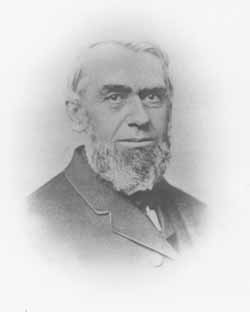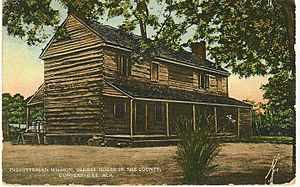Marius Robinson facts for kids
Marius Robinson (1806-1878) was an American minister and a strong supporter of ending slavery. He edited two important anti-slavery newspapers: The Philanthropist and The Anti-Slavery Bugle.
While studying at Lane Seminary, Marius helped start a school for African Americans in Cincinnati, Ohio. Even when many people in the city were against it, he kept teaching. He was one of the brave students known as the Lane Rebels. These students refused to stop working to improve the lives of African Americans. Marius Robinson also traveled to give speeches against slavery. He worked closely with his wife, Emily Rakestraw Robinson, to fight for freedom and equality.
Contents
Early Life and Calling
Marius Racine Robinson was born on July 29, 1806. His family lived in Dalton, Massachusetts. They were strict Presbyterians. In 1816, his family moved to Orville, Chautauqua County, New York.
When Marius was 15, he attended a religious meeting led by Charles Grandison Finney. This experience made him feel a strong call to help others. He decided he wanted to serve people through his faith.
Education and Activism
Marius knew he needed an education. To pay for it, he became an apprentice in 1823. For four years, he learned bookbinding and printing in Utica, New York. Reading the books he helped make taught him a lot. His uncle, Reverend Arthur Darwin, also taught him privately. During this time, Marius studied the Bible and taught Sunday school.
In 1829, Marius continued his studies at the Creek Path Mission. This mission was in the Cherokee Nation. He worked there as an assistant, helping Native American children. After a year, he became an assistant at a Presbyterian Church in Florence, Alabama.
Around this time, Marius became interested in the Second Great Awakening. This was a religious movement that encouraged people to do good works. It led him to support humanitarian causes, especially the movement to end slavery.
Studying at University
In 1830, Marius enrolled at the University of Nashville. He studied theology, which is the study of religion. Some of his teachers didn't like his modern ideas. He graduated with high honors in 1832.
At the university, Marius met Theodore Dwight Weld. Weld was a leader in the anti-slavery movement. He also helped start Lane Seminary in Cincinnati, Ohio. Marius decided to enroll at Lane Seminary. The seminary taught new ideas about faith and social action.
The Lane Rebels
At Lane Seminary, Marius and other students were very committed to ending slavery. They actively helped African Americans. Marius even took a year off from his studies. He helped Augustus Wattles create a school for Black adults and children. They taught subjects like math, grammar, and Bible study.
Many people in Cincinnati didn't like these efforts. They criticized the school and other anti-slavery activities. The seminary's leaders told the students to stop their projects. In protest, Marius and 39 other students left the seminary. They became known as the Lane Rebels. This group became very important in the anti-slavery movement in the western United States.
Fighting for Freedom
After leaving Lane Seminary, Marius Robinson and Augustus Wattles stayed in Cincinnati. Marius continued to teach and work as a missionary for the free Black community. In 1834, Emily Rakestraw, a Quaker from New Garden, Ohio, came to Cincinnati. She was one of several women who answered an ad to teach Black women.
Emily and Marius worked long hours as volunteers in Cincinnati's schools. Many people in the city were against their efforts. They didn't want slavery to end, or for Black people to be educated and treated equally. This danger brought Marius and Emily closer. They married and worked together against slavery for the rest of their lives.
A Voice for Change
In 1836, Marius became an evangelist, a type of minister. He was asked to encourage churches to take action against slavery in America.
That same year, Marius joined The Philanthropist. This was an anti-slavery newspaper started by the Ohio Anti-Slavery Society. James G. Birney was its editor. On July 30, 1836, a mob attacked the newspaper office. Marius quickly saved the printing plates. He rode horseback to Wilmington, Delaware, to get the paper printed there. After a few days, he and Birney returned to Cincinnati.
Marius was a Presbyterian minister. From 1830 to 1865, he gave many speeches about slavery and freedom. He spoke at the American Anti-Slavery Society meetings in Ohio. While Marius traveled, Emily stayed in Cincinnati and taught.
Facing Danger
Abolitionists often faced angry mobs. In June 1837, Marius was attacked in Berlin, Trumbull County, Ohio. A brave woman, Mrs. Garretson, tried to protect him. She was hurt in the process. The mob then injured Marius and covered him with tar and feathers. They took him about 10 miles out of town. But Marius found new clothes and walked back to Berlin to give his speech.
The attack left Marius very ill. He had to rest for a month before he could speak again. His health suffered for months afterward. Marius knew how dangerous it was to speak out. After another abolitionist, Elijah Parish Lovejoy, was killed in November 1837, Marius wrote that he feared more violence would come. For ten years, he lived on a farm in Putnam, Ohio.
Leading the Movement
The anti-slavery movement grew stronger in Ohio during the 1840s. In 1850, Marius became the president of the Western Antislavery Society. This group was based in Salem, Ohio. It had members from Ohio, Michigan, Indiana, and Pennsylvania.
On May 24, 1851, Marius became the publisher of the society's newspaper, The Anti-Slavery Bugle. It was a very successful paper. Marius supported the ideas of other strong abolitionists like William Lloyd Garrison. He believed in the slogan "No Union with Slaveholders," meaning no unity with states that allowed slavery.
Marius also supported women's rights and temperance (avoiding alcohol). He was against war and the death penalty. His wife, Emily, was one of the first anti-slavery feminists. She worked for the newspaper until 1854. Marius retired from the paper in February 1859. Later, he ran a hat store and led an insurance company. During the American Civil War, he actively raised money and gave speeches. Emily continued her work for social change after the war.
Marius Robinson also helped people escape slavery as an Underground Railroad agent.
Family Life
Marius married Emily Rakestraw on November 19, 1836, in Delphi, Ohio. Emily was an abolitionist who went to Cincinnati to teach African Americans, even though her parents didn't approve. Emily's Quaker family was worried because Marius was not a Quaker. Marius had not met Emily's family before they married.
At first, Emily's family didn't accept the Robinsons. But Marius gave an anti-slavery speech in New Garden, Ohio, Emily's hometown. After hearing him speak, her parents began to like her new husband.
Marius Robinson passed away in Salem, Ohio, on December 9, 1878. Emily died on July 20, 1897, at 86 years old.
Marius Racine Robinson's important papers are kept at the Western Reserve Historical Society. Emily later wrote a book called Our Old Anti-Slavery Tent. She wrote it after Susan B. Anthony asked her to share her memories of the anti-slavery movement.
Images for kids




